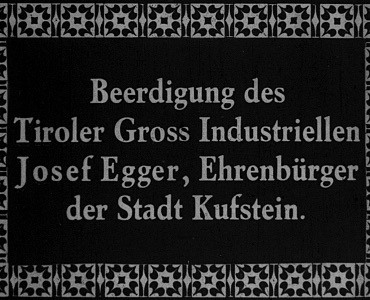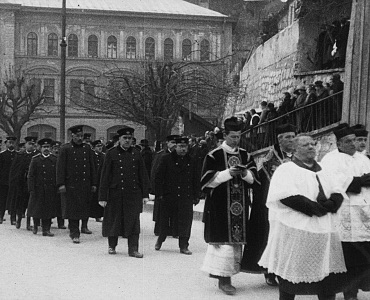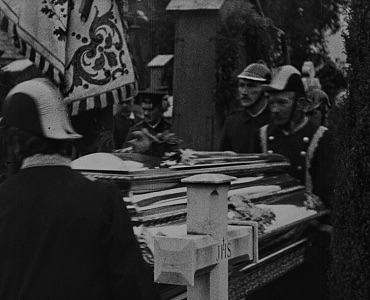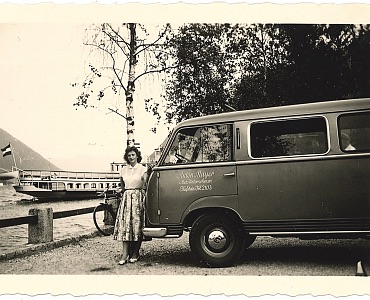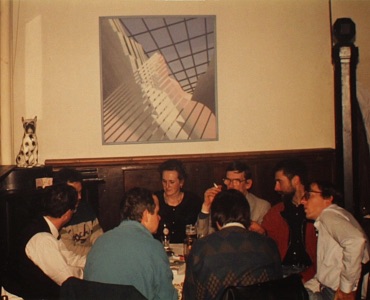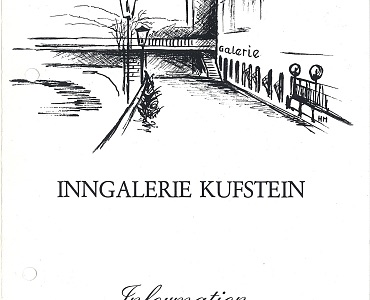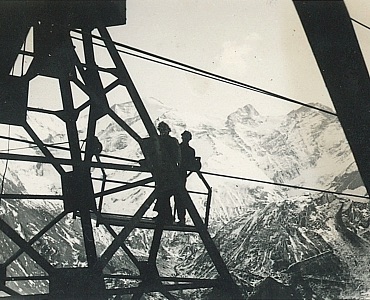Finds from the past
Research for a book on the history of Kufstein in the 20th century is in progress. In order to give an insight into the progress we will present finds that have come to light as a result of enquiries in the city. If you have memories or photos to share, or if you have anything to add to the items presented here, such as comments, etc., please contact us at stadtgeschichte@stadt.kufstein.at.
Group of soldiers before leaving for the front
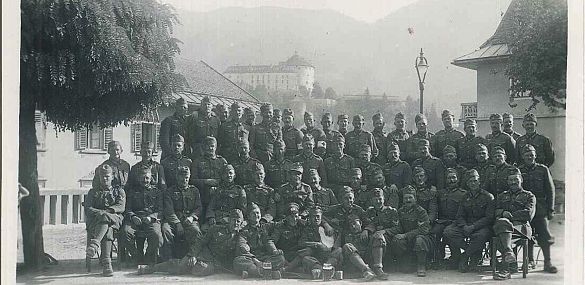
On the back of the photo is the note: “Group of soldiers before leaving for the front.” In this case the front was in Poland at the end of 1939. This attack by troops of the National Socialist state was the military start of World War II. Mathias Mayer (in the 2nd row, 7th from the left) had survived World War I and went into the World War II as a platoon leader with the comrades pictured. He returned, which was not the case for many of his pictured comrades. The plaque on the Calvary Chapel behind the cemetery gives an impression of their fates. Afterwards, he joined other survivors in the “Verein der Kaiserjäger” (Association of Austrian Infantrymen)
For picture and information thanks to: Monika Egger
Funeral of the Tyrolean industrialist Josef Egger, honorary citizen of Kufstein
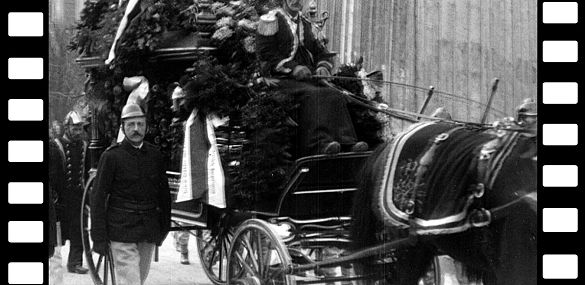
The funeral, on 15 January 1926, is the third oldest known film documentary. Before that the only films made were at the home of Emperor Franz Josef and one of King Ludwig III and Maria Theresa of Bavaria. Josef Egger, company and hotel owner and mayor of Kufstein from 1904 to 1919, was therefore in the very best of company. On 13 January 1926, the “Tyrolean border courier” from Kufstein wrote about himself: “During the years of his administration, Kufstein changed its outer image and reputation so favourably that the older people would hardly have recognised it. He was also praised for his good deeds for the poor people in the city as well as his initiatives in the field of tourism.” In the end a sense of peace enveloped the grave.
Thanks for the picture and information go to: Club Director Erwin Weiskirchner, Film & Video Club Kufstein [http://videoclub-kufstein.org/], who is interested in films from/about Kufstein before 1990.
Who knows “Lachi Lachi”?
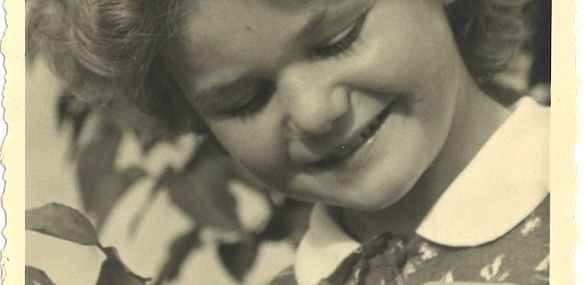
The nickname reminds many locals of a small, gaunt man who wandered through the city equipped with a camera until his death in 1970. He used the camera to capture street scenes and was also asked to take portraits. “My parents wanted to have a nice photo of me and therefore went to him,” remembers Ilse Buder. The picture shows the result. With a “Lachi Lachi” (smile smile), he tried to get people to give him a friendly expression for the photo, which led to his well-known nickname. He probably came from the Ukraine, although other people remember different countries of origin. After World War II he lived in the camp for displaced persons in the Weissach district, where he was known as Ushakov. Over the years this became a shanty town, and he later moved to Eichelwang. We are interested in the following questions: Who knows more about Lachi Lachi and can tell us more about his biography? Does anybody have more photos ¬– either ones that he took or photos that show him?
Thanks for the picture go to: Ilse Buder. The information is compiled from several conversations.
Harald Pickert: Drawings of everyday life in a concentration camp
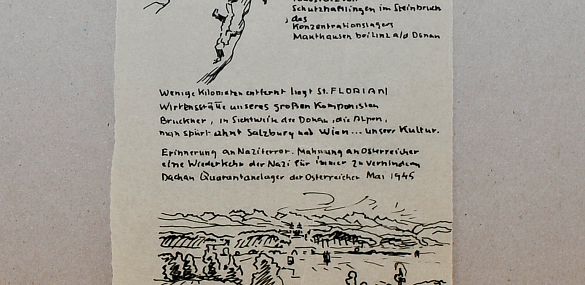
In spring of 1939, troops of the Nazi state occupied what was known as “the rest of Czechia.” This also affected the printing works and publishing house of Harald Pickerts. Born in 1901 and raised in Kufstein, in 1928 he moved to Leitmeritz, Czech Republic (the Czech name is Litomerice) and took over the family business there. His publishing and journalistic activities caused the NS regime to classify him as a “public enemy,” leading to his arrest. He was imprisoned as a “political prisoner” in the concentration camps Sachsenhausen, Mauthausen and Dachau between 1939 and 1945 before returning to Kufstein. He never wanted to talk about his experiences but in 2015 his descendants found a folder with drawings and pictures. Harald Pickert made them in the Dachau concentration camp shortly before its liberation by the Allies.
Thanks for the picture and information go to: Hubert Berger
The first taxi in Kufstein
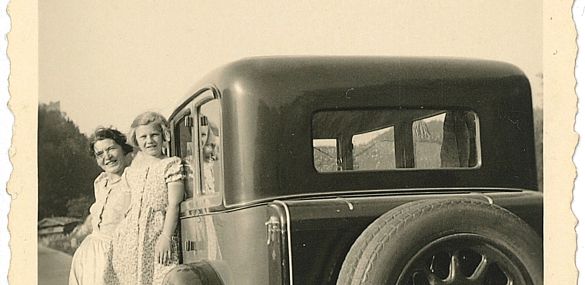
Around 1920, Anton Mayer (1894-1970) purchased a taxi. It was the first in Kufstein and the first of his vehicles, which would eventually also include a Ford bus. From the 1930s onwards, several companies shared the telephone in the taxi office, and jobs were assigned in a sequence. The Mayer taxi company transported the city's industrialists, organised excursions by bus and, particularly from the 1950s onwards when tourism in Kufstein experienced a boom, transported travellers from the railway station to hotels and guesthouses or brought guests home from pubs at night. The taxi business developed in parallel with the infrastructure in Tyrol. In the second half of the 20th century, roads were built all over the country, with the motorway seen as a promise of progress and a link to the rest of Europe. Work, leisure and holidays changed dramatically with the possibilities that a car, truck, tractor or motorbike provided. Perhaps you also have memories or stories about your first private vehicle, or photos of it...
Thanks for pictures and information go to: Inge Schöner, daughter of Anton Mayer. She is pictured as a ten year old with her mother next to the first taxi and also as an adult at Lake Achensee.
Rooms for fine arts
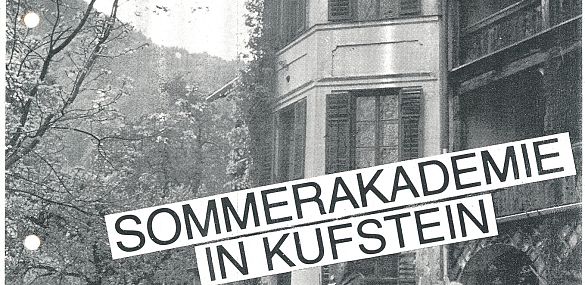
There were small niches that offered space for visual art in Kufstein; we use them to remember the artists. They include the painter Sieghilde Pirlo-Hödl, who presented her artistic activities in lectures, for example in 1964 at the art school of Prof. Rosen at the fortress. Later she led a small circle of painters. Some of the same people were active in the “School for Fine Arts” at the Edschlößl, which was founded by Hubert Schweitzer in 1981. It was within these circles that the idea of founding a gallery developed. The Inngalerie opened in 1984. The 1990s were a busy time for the fine arts with newspaper reviews in “Kufstein aktuell” of more than 100 exhibitions between 1988 and 1993. Art venues included Club Double Six, the town hall, the Volksbank, the furniture store Gall. However the considerable grass roots energy couldn’t be maintained in the long term without public support. Initiatives ran out of steam and artists moved away. Closure of the Inngalerie in 2004 was probably the final point.
Thanks for pictures and information go to visitors of the 2nd narrative café: Margareta Langer, Emmerich Litzko, Stephan Obergmeiner and Martin Wagner
Contemporary witnesses wanted for the Option Agreement!
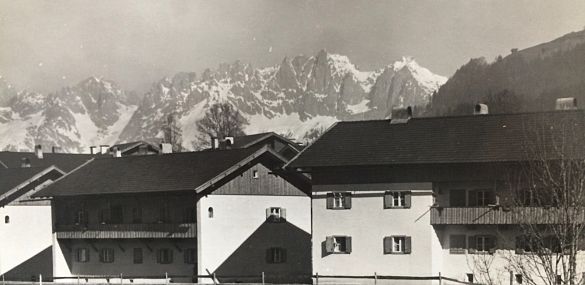
In 1939, the dictators Hitler and Mussolini concluded the so-called “South Tyrol Option Agreement.” German-speaking South Tyroleans and Ladins were faced with a choice between remaining in their homeland and becoming “loyal” Italians, or emigrating to the German Reich. Because they were exposed to linguistic and cultural oppression in Italy, about 86% opted for resettlement. In the end about 75,000 people emigrated to the German Reich, many of them to Ostmark, as Austria was called at the time. Some came to Kufstein and found a new home here. We are looking for Kufstein residents from South Tyrol who are willing to tell their life stories to a team led by Prof. Eva Pfanzelter from the Institute of Contemporary History at the University of Innsbruck. We are also looking for photos and documents from this period. If you are interested, please contact Ulrich Wendl (Ulrich.Wendl@student.uibk.ac.at). We hope for your support and look forward to hearing your stories!
Thanks for the picture go to: Archive New Home Tyrol (NHT)
From Kufstein to Kaprun and back
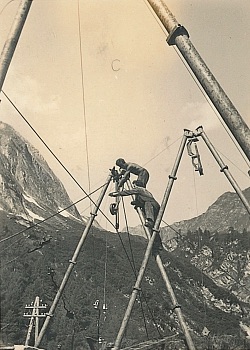
The idea of producing electricity with a gigantic hydroelectric power station in the Hohe Tauern Mountains can be traced back to the 1920s. In 1938, representatives of the NS regime broke ground in Kaprun and by the end of the war limited electricity was being produced. After the war, Kaprun became a symbol of reconstruction, mainly financed by funds from the European Recovery Program (ERP, also known as the “Marshall Plan”). What’s the connection with Kufstein? So far, information that the Lechner cement plant supplied the construction site is vague but what is certain is that four people from Kufstein earned good money there for several seasons in the early 1950s. Anna Zweibrot told us that her husband was able to buy two bicycles, one for himself and one for her. “When he gave me a bicycle I had to go and visit him.” In 1950, she cycled from Kufstein to Kaprun (85 km), “but I went back by post bus” she says laughing. It was around this time that some Kufstein locals left the town to earn good money abroad. Do you have such a story or can you tell stories about your ancestors?
Thanks for the picture and information go to: Anna Zweibrot
A cross as a symbol for post-war history
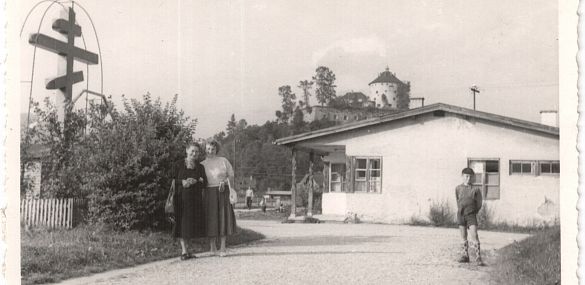
The cross on the picture is located in the Kufstein Peace Settlement and bears the inscription “ПАМЯТКА УКРАЇНСЬКОЇ КАТОЛИЦЬКОЇ СВ МІСІІ 1945”* or “Souvenir of the Ukrainian Catholic holy mission in 1945.” It comes from the Kufstein UNRRA** camp for displaced persons, which was home to people who had been expelled or deported from their homes during the war, prisoners of war, but also those who had sided with National Socialist Germany and did not want to return to their home countries. When the camp was closed in the 1950s many of the inhabitants who remained there moved to the Peace Settlement. With them moved the cross, which had weathered over the decades and was restored and consecrated again a few years ago.
Behind the symbol of the cross are countless stories of life in the UNRRA camp and the Peace Settlement. Do you have a story to tell or do you know another symbol in the city that has more to it than meets the eye?
* “PAMJATKA UKRAJINS ‘KOJI KATOLYC’ KOJI SV MISIJI 1945”
** UNRRA = United Nations Relief and Reconstruction Administration
Thanks for the pictures and information go to: Marju Jurschick-Bäumel and Raimund Feher
Far from Europe – Tyrol unmasked
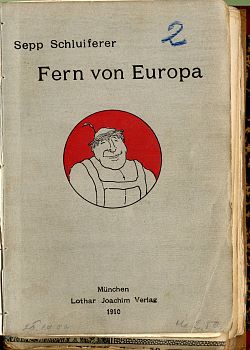
The book “Fern von Europa,” (far from Europe), which was published 110 years ago in 1909, caused quite a stir in Tyrol. The search was on for the author who wrote this diatribe under the pseudonym “Sepp Schluiferer.” It portrayed Tyrolians as backwoods, stupid and simple-minded, a description that they were not at all happy about.
A few weeks after the book was published, the author was unmasked in December 1909 and had to flee to Munich to escape public anger. It seems obvious that all the book reviews in Tyrol tore the work apart, failing to recognise the satirical intention of the author, who, as he writes in the preface, “studied a people on whom time passes without a trace.”
Now that a new book “Kufstein in the 20th century” is being worked on, the Kufstein municipal theatre has set itself the task of translating events from this period into a theatrical form. This book definitely made the blood of the Kufstein residents boil.
Thanks for the picture go to: Tyrolean State Museum/Library of the Ferdinandeum
Waterproof piecework and home-based work
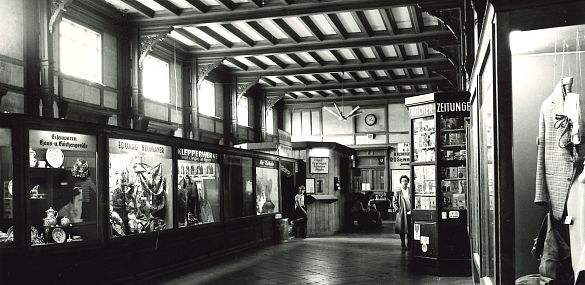
On 5 March 1966, the Kufstein-based Klepper production plant advertised in the “Tiroler Grenzlandboten” looking for “skilled women and girls.” The Klepper company, from Rosenheim, had been producing folding boats since 1907 as well as waterproof clothing for the military, railways and post office since 1920. Klepper coats became infamous under National Socialism as “Gestapo coats,” but after 1945 regained their neutrality as lightweight, air-permeable rain protection. Kufstein was the production location for a range of products, for example “Aquastop” coats and capes for which the cut parts were first sewn together and the seams then glued. Several dozen women carried out this work as piecework in the Klepper factory in Carl-Wagner-Straße or produced parts of the clothing at home. The rainwear was advertised, among other things, in a showcase in the station concourse.
Did you or someone you know work for Klepper or did you do piecework or home-based work for another company?
Thanks for the photograph go to: ÖBB GB Company
Finest table oil
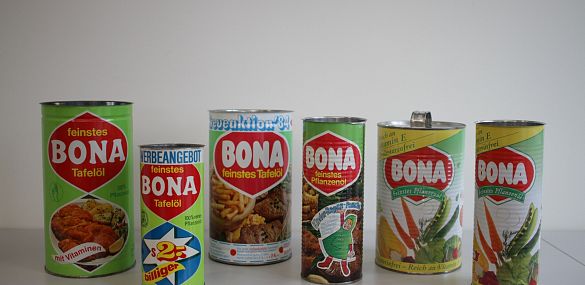
With industrial-scale production came the need to package goods for distribution. One solution for this was tin cans and the Pirlo company in Kufstein started production in 1908. In the beginning the main customers were skin and shoe cream manufacturers, but from the 1950s onwards the food industry became increasingly important. It was looking for packaging for goods such as the “Bona” brand oil. The picture shows 1 and 2 litre containers as they were produced for domestic use from the end of the 1960s up to the present (from left to right). Only small details have changed: The “O” in the brand name became more rounded, the description changed from “table oil” to “vegetable oil” and the images reflect the changing food culture. In the beginning they showed schnitzel and French fries while later this changed to peas and carrots. Over more than 50 years of the brand, “Bona tins” have found their place in many Austrian kitchens and been an everyday sight.
Thanks for picture and information go to: Julius Lüthi
Visions of the city and utopias
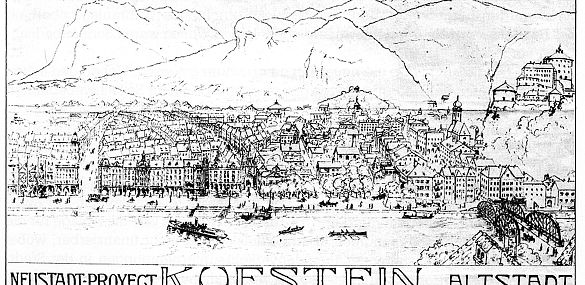
How a city can develop structurally is the question asked at the start of every urban planning project. In Kufstein, the answers can be seen in the face of the modern town. However, in addition to the many existing buildings, in the 20th century there were also a variety of urban visions and utopian projects that were not realised for various reasons. These include the Hohenstaffing hotel complex, which was going to be built around 1900 on Thierberg as a sophisticated accommodation facility with 200 rooms and 18 salons, or a castle hotel on the fortress grounds. Other visions, such as the “Neustadt-Proyect” (pictured) by the artist Sebastian Defregger are from the same period. This project included a representative row of houses along the Inn River and was adopted decades later in a modern form. How Kufstein has changed, which plans were implemented, and which utopias remained unrealised can be read in the book “Streets, buildings and squares” by Arnold Klotz.
The Kufstein winter of the century

“From February to the end of April there was a huge amount of snow,” wrote the Kirchbichl chronicler Andrä Fluckinger about the winter of 1907 in the district of Kufstein. She then continued: “14.2. enormous masses of snow – never before in living memory. Hardly a fencepost can be seen poking out of the snow, roofs have caved in, and the mountains are absolutely covered.” 22 years later, Tyrol suffered from the lowest temperatures since meteorological records began, and February 1956 also brought a “cold snap to Central Europe.” Temperatures were below -28 °C! A truly icy time, when it was better to stay at home with a warm stove. Perhaps you experienced that freezing cold February 1956 or you can tell us about other winters in which cars, bushes and roofs disappeared under a thick blanket of snow? We are looking for information about the Kufstein winter of the century and any memories or images associated with it.
Thanks for the photos and information foes to: Regina Götz-Santer and Veronika Spielbichler [https://vero-online.info/wetterkapriolen-sind-nichts-neues-ein-blick-in-die-chronik/]
Cheating the shame
In August of this year, filmmaker Ruth Beckermann presented a film at the European Forum in Alpbach under the title “Encounters: Without Fear.” She presented five artists who had proven in the course of their lives that they could make decisions, which also helped the general public, without fear. Among them was the 66-year-old Austrian composer Georg Friedrich Haas, who talked about the influence of the National Socialist movement on his family, his life and his work. He explained his reasons for not taking a stand until so late in his life by quoting the 4th commandment (“Thou shalt honour thy father and mother”).

